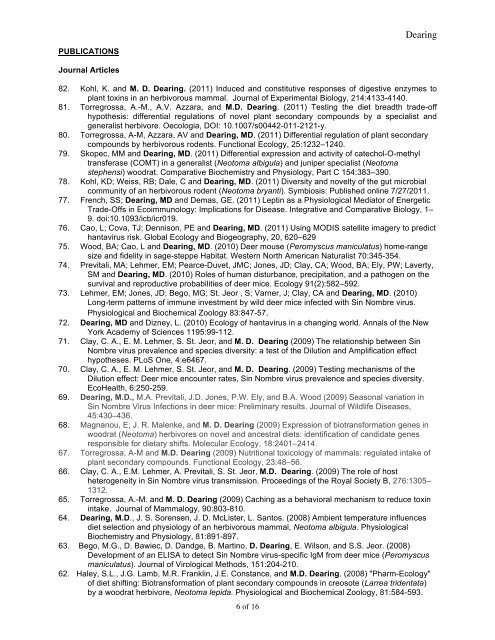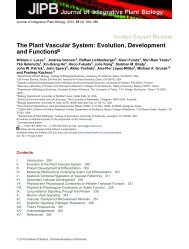Curriculum Vitae - Department of Biology - University of Utah
Curriculum Vitae - Department of Biology - University of Utah
Curriculum Vitae - Department of Biology - University of Utah
Create successful ePaper yourself
Turn your PDF publications into a flip-book with our unique Google optimized e-Paper software.
PUBLICATIONS<br />
Journal Articles<br />
6 <strong>of</strong> 16<br />
Dearing<br />
82. Kohl, K. and M. D. Dearing. (2011) Induced and constitutive responses <strong>of</strong> digestive enzymes to<br />
plant toxins in an herbivorous mammal. Journal <strong>of</strong> Experimental <strong>Biology</strong>, 214:4133-4140.<br />
81. Torregrossa, A.-M., A.V. Azzara, and M.D. Dearing. (2011) Testing the diet breadth trade-<strong>of</strong>f<br />
hypothesis: differential regulations <strong>of</strong> novel plant secondary compounds by a specialist and<br />
generalist herbivore. Oecologia, DOI: 10.1007/s00442-011-2121-y.<br />
80. Torregrossa, A-M, Azzara, AV and Dearing, MD. (2011) Differential regulation <strong>of</strong> plant secondary<br />
compounds by herbivorous rodents. Functional Ecology, 25:1232–1240.<br />
79. Skopec, MM and Dearing, MD. (2011) Differential expression and activity <strong>of</strong> catechol-O-methyl<br />
transferase (COMT) in a generalist (Neotoma albigula) and juniper specialist (Neotoma<br />
stephensi) woodrat. Comparative Biochemistry and Physiology, Part C 154:383–390.<br />
78. Kohl, KD; Weiss, RB; Dale, C and Dearing, MD. (2011) Diversity and novelty <strong>of</strong> the gut microbial<br />
community <strong>of</strong> an herbivorous rodent (Neotoma bryanti). Symbiosis: Published online 7/27/2011.<br />
77. French, SS; Dearing, MD and Demas, GE. (2011) Leptin as a Physiological Mediator <strong>of</strong> Energetic<br />
Trade-Offs in Ecoimmunology: Implications for Disease. Integrative and Comparative <strong>Biology</strong>, 1–<br />
9. doi:10.1093/icb/icr019.<br />
76. Cao, L; Cova, TJ; Dennison, PE and Dearing, MD. (2011) Using MODIS satellite imagery to predict<br />
hantavirus risk. Global Ecology and Biogeography, 20, 620–629<br />
75. Wood, BA; Cao, L and Dearing, MD. (2010) Deer mouse (Peromyscus maniculatus) home-range<br />
size and fidelity in sage-steppe Habitat. Western North American Naturalist 70:345-354.<br />
74. Previtali, MA; Lehmer, EM; Pearce-Duvet, JMC; Jones, JD; Clay, CA; Wood, BA; Ely, PW; Laverty,<br />
SM and Dearing, MD. (2010) Roles <strong>of</strong> human disturbance, precipitation, and a pathogen on the<br />
survival and reproductive probabilities <strong>of</strong> deer mice. Ecology 91(2):582–592.<br />
73. Lehmer, EM; Jones, JD; Bego, MG; St. Jeor , S; Varner, J; Clay, CA and Dearing, MD. (2010)<br />
Long-term patterns <strong>of</strong> immune investment by wild deer mice infected with Sin Nombre virus.<br />
Physiological and Biochemical Zoology 83:847-57.<br />
72. Dearing, MD and Dizney, L. (2010) Ecology <strong>of</strong> hantavirus in a changing world. Annals <strong>of</strong> the New<br />
York Academy <strong>of</strong> Sciences 1195:99-112.<br />
71. Clay, C. A., E. M. Lehmer, S. St. Jeor, and M. D. Dearing (2009) The relationship between Sin<br />
Nombre virus prevalence and species diversity: a test <strong>of</strong> the Dilution and Amplification effect<br />
hypotheses. PLoS One, 4:e6467.<br />
70. Clay, C. A., E. M. Lehmer, S. St. Jeor, and M. D. Dearing. (2009) Testing mechanisms <strong>of</strong> the<br />
Dilution effect: Deer mice encounter rates, Sin Nombre virus prevalence and species diversity.<br />
EcoHealth, 6:250-259.<br />
69. Dearing, M.D., M.A. Previtali, J.D. Jones, P.W. Ely, and B.A. Wood (2009) Seasonal variation in<br />
Sin Nombre Virus Infections in deer mice: Preliminary results. Journal <strong>of</strong> Wildlife Diseases,<br />
45:430–436.<br />
68. Magnanou, E; J. R. Malenke, and M. D. Dearing (2009) Expression <strong>of</strong> biotransformation genes in<br />
woodrat (Neotoma) herbivores on novel and ancestral diets: identification <strong>of</strong> candidate genes<br />
responsible for dietary shifts. Molecular Ecology, 18:2401–2414.<br />
67. Torregrossa, A-M and M.D. Dearing (2009) Nutritional toxicology <strong>of</strong> mammals: regulated intake <strong>of</strong><br />
plant secondary compounds. Functional Ecology, 23:48–56.<br />
66. Clay, C. A., E.M. Lehmer, A. Previtali, S. St. Jeor, M.D. Dearing. (2009) The role <strong>of</strong> host<br />
heterogeneity in Sin Nombre virus transmission. Proceedings <strong>of</strong> the Royal Society B, 276:1305–<br />
1312.<br />
65. Torregrossa, A.-M. and M. D. Dearing (2009) Caching as a behavioral mechanism to reduce toxin<br />
intake. Journal <strong>of</strong> Mammalogy, 90:803-810.<br />
64. Dearing, M.D., J. S. Sorensen, J. D. McLister, L. Santos. (2008) Ambient temperature influences<br />
diet selection and physiology <strong>of</strong> an herbivorous mammal, Neotoma albigula. Physiological<br />
Biochemistry and Physiology, 81:891-897.<br />
63. Bego, M.G., D. Bawiec, D. Dandge, B. Martino, D. Dearing, E. Wilson, and S.S. Jeor. (2008)<br />
Development <strong>of</strong> an ELISA to detect Sin Nombre virus-specific IgM from deer mice (Peromyscus<br />
maniculatus). Journal <strong>of</strong> Virological Methods, 151:204-210.<br />
62. Haley, S.L., J.G. Lamb, M.R. Franklin, J.E. Constance, and M.D. Dearing. (2008) "Pharm-Ecology"<br />
<strong>of</strong> diet shifting: Biotransformation <strong>of</strong> plant secondary compounds in creosote (Larrea tridentata)<br />
by a woodrat herbivore, Neotoma lepida. Physiological and Biochemical Zoology, 81:584-593.

















